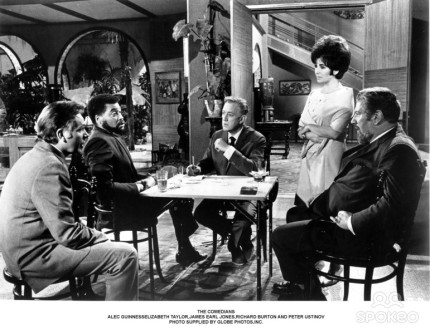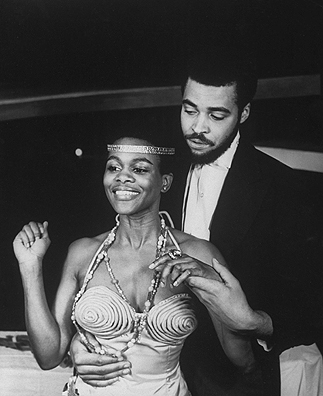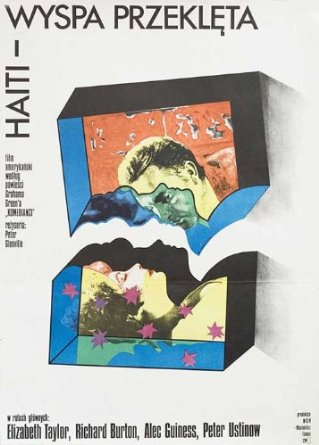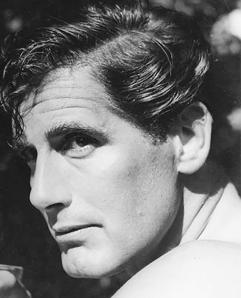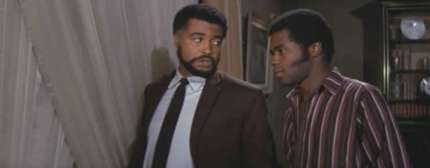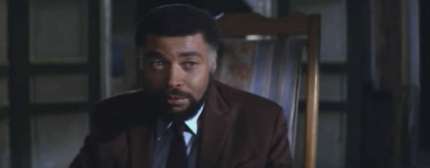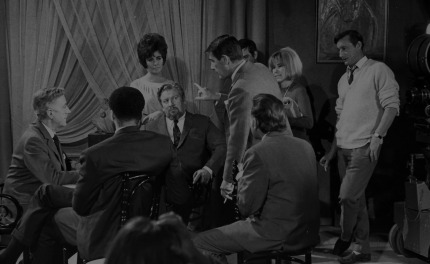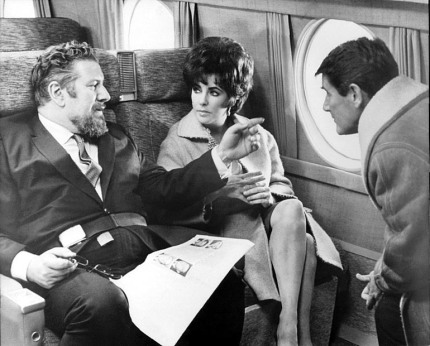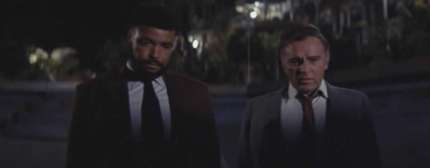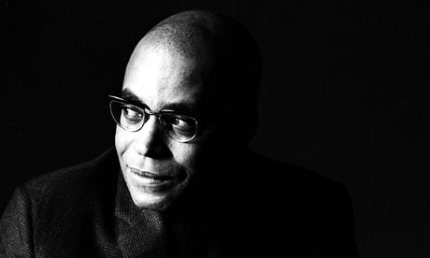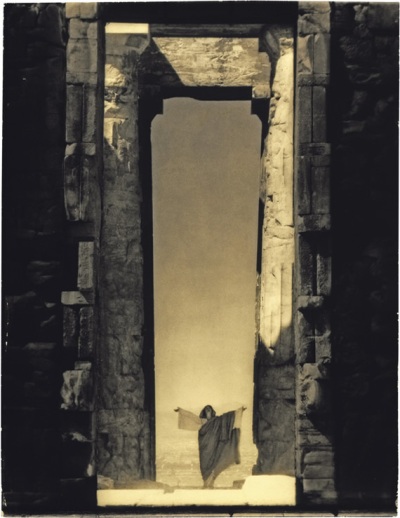Tag Archives: Movie Stars
JAMES EARL JONES REMEMBERS ( Filming “THE COMEDIANS” with Richard Burton, Elizabeth Taylor, and Alec Guinness )
Long before he provided the ominous tones for Darth Vader and created the most iconic-sounding villain in screen history, James Earl Jones made his mark in a number of major productions of stage and screen. It was his role in Jean Genet’s groundbreaking play The Blacks, first staged in New York in 1961, and running for a record-breaking 1408 performances, that led to one of his most memorable early film experiences.
Peter Glenville, a leading British director of the time who had closely collaborated with Graham Greene and Tennessee Williams, was looking for a number of black actors to take roles in his forthcoming film of Greene’s The Comedians, set amidst the turmoil of ‘Papa Doc’ Duvalier’s Haiti. Going to The Blacks, which was one of the top off-Broadway hits of the decade, Glenville was presented with an embarrassment of acting riches. Jones was not the only one to be cast in the film as a result of his performance in the play: joining him were Cicely Tyson, Zakes Mokae, and Roscoe Lee Brown. Also in the film was a young Gloria Foster, who later made a mark as the Oracle in the first two Matrix pictures.
For Jones, working on The Comedians was memorable both on, and off, screen. For rarely can a young actor have found himself spending time with such a luminous A-list cast: Elizabeth Taylor, Richard Burton, Alec Guinness, Peter Ustinov, not to mention the legendary star of silent pictures, Lillian Gish.
A few years ago I produced an oral history of the life and work of Peter Glenville, and James Earl Jones kindly agreed to share his reminiscences with Susan Loewenberg, Producing Director of L.A. TheatreWorks, who commissioned the history on behalf of the Peter Glenville Foundation.
The segment about The Comedians was my favorite, enlivened by Jones’s commentary, his extraordinary presence, and that voice. (In a technical sidebar, that voice was so resonant with bass frequencies that the engineer had quite some trouble recording it without distortion).
Now you can enjoy his story too……
Narrator: Martin Jarvis. Voice of Peter Glenville: Simon Templeman.
LILLIAN GISH in “The Wind”
In celebration of Lillian Gish whose 120th birthday falls today. Below you can watch her introducing one of her greatest films, The Wind (1928).
It is one of the most remarkable American films of the silent era, produced by its star, and helmed by the Swedish director Victor Sjostrom (anglicized to Seastrom), who later in life played the old Professor in Ingmar Bergman’s “Wild Strawberries”.
The version to see is the one presented by TCM in collaboration with Oscar-winning film historian, Kevin Brownlow, with a specially composed musical score by Carl Davis. (Music buffs might be interested to know that the orchestrators on this score, which includes all manner of orchestral “special effects”, were Colin and David Matthews, leading avant-garde composers in their own right. Colin has also worked extensively with the Benjamin Britten Estate to bring many of Britten’s “lost” compositions back into the repertoire).
I attended the premiere of this version of The Wind at the London Film Festival in the 80s, and it was a knockout.
At a later screening in New York’s Radio City Music Hall I had a chance to meet Ms. Gish, and she was the personification of charm and old-world Hollywood graciousness. The following clip, alas, features music other than Carl’s, but it gives you an idea of the extraordinary imagery that drives this story of a girl pushed to the limit of her sanity by events in this inhospitable, windswept country.
HOLLYWOOD by STEICHEN
Years before Gloria Swanson declared she was ready for her close-up and took the long walk down that storied staircase on Sunset Boulevard, she sat for another close-up with the legendary photographer Edward Steichen, and created the indelible image above.
It’s an image which embodies something essential about our relationship with screen goddesses. The combination of her direct gaze, mediated by the presence of a veil, captures the pull-push dynamic of the Hollywood glamour shot at its zenith. “Come here, this is all for you, just for you, EXCEPT — don’t touch! Merely watch. Keep your distance. Get too close and you might end up like William Holden — face down in my swimming-pool.”
The other day I was strolling with my 16 year-old daughter through the Los Angeles County Museum of Art (which, funnily enough, we had reached by driving down Sunset Boulevard), when we found ourselves confronted with the arresting image of Gloria Swanson in her prime. We were in an obscure corner of the American galleries and had stumbled upon a treasure trove of Edward Steichen’s work, some of it less well-known.
It was a newly endowed collection of Steichen’s photos, focusing mainly on Hollywood stars and some choice photos from the pages of Vogue and Vanity Fair. It’s fair to say that during his years working for Conde Nast, Steichen more or less invented glamour photography and the high toned advertising money-shot. “Steichen was a perfectionist,” says Howard Schatz, a fashion photographer whose portraits of actors appear in Vanity Fair. “His precise eye for lighting and design makes his pictures from the ’20s and ’30s, though clearly of their time, still much admired by fashion photographers today.”
Steichen is the photographer by whom all others must be judged. His photos feel as if they are alive, and his portraits – drawing on his background as an accomplished painter – use light and shade to draw out the inner life of his subjects like an old master. Indeed, walking past a Sargent and a Rembrandt later in our perambulations we did not find Steichen wanting in the comparison.
In fact, in this early self-portrait which opens the exhibit, you can see how Steichen has physically manipulated the emulsion to bring a mysterious, painterly quality to the image. It’s as if the subject of the self-portrait wants to hide within the image.
Contrast this with his famous self-portrait of later years which is all about the virtues of modern photography: clarity and candor in the pose and lighting. Yet there is a mysterious force in those eyes, a power that draws the viewer in. “See what I see” they temptingly offer, “if you dare.”
Looking at the photos of Hollywood celebrities, it was striking how Steichen had managed to reveal some of the more hidden corners of his subjects’ personalities, and in the process modify the way we view them.
Chaplin’s obsessiveness –
Lillian Gish’s poise, confidence, and a beauty more profound than that habitually revealed by the moving camera in her films….
Clara Bow’s sadness and even loneliness – all the flap of the “It” girl lost in a gaze to a horizon she can no longer see….
Garbo’s abiding discomfort within her own skin….
Loretta Young, stranded at the top of a staircase, seems lost and imprisoned at the same time….
Douglas Fairbanks, almost lost in shadow, shares an intimacy with Joan Crawford…
This photo of Walt Disney (not in the exhibit, but I just had to include it) is prescient in its placing of Mickey and Minnie in the power position. Walt looks like a man trying to shake off a pair of gremlins whose malevolence has been manifested in oversized ears. “Yes” he seems to say of his teenage offspring,”I know they’re mine, but you can’t hold me responsible for everything they get up to!”

Again not in the exhibit is this portrait of legendary interpretive dancer, Isadora Duncan. The setting perfectly mirrors her absorption in classical notions of dance….
The exhibit is rounded out by some non-celebrity photos, providing a resonance that seems to then inform how one looks at the more famous portraits. (Unfortunately I could not find online samples of Steichen’s early “product placement” advertising shots).


My daughter declared the following her favorite. I am inclined to agree. Steichen has caught a sublime moment of connection between a couple. Completely wrapped up in each other, they see not the world around them. But for the prescience of the lurking photographer, we easily might not have seen them either.

Photography records the gamut of feelings written on the human face, the beauty of the earth and skies that man has inherited, and the wealth and confusion man has created. It is a major force in explaining man to man.
Edward Steichen (1879 – 1973)
THE GARBO EFFECT
Today would have been Greta Garbo’s 108th birthday. She is still considered one of the greatest sirens of the silver screen, a truly iconic figure embodying all the mystery and allure that the camera can bestow on the feminine form.
Want proof? Look no further than the following.
The year was 1926.
Filming a pivotal scene for Flesh and the Devil, the story of an illicit romance á la Anna Karenina, director Clarence Brown had little idea of how life was about to mirror art.
It was the scene where the leading lady, Greta Garbo, was to meet her great love, John Gilbert, for the first time. In real life as well as on screen.
It’s the scene in the train station (alas, not available in clip form). When you watch it, you can almost believe you are watching the actors falling in love at the same time as their characters do. According to Gilbert’s daughter, Leatrice Gilbert Fountain, whom I met at a screening of the film in New York, that is exactly what happened.
Director Clarence Brown later remarked upon his leading lady: “She had something behind the eyes that told the whole story. On the screen Garbo multiplied the effect of the scene I had taken. It was something she had that nobody else ever had.”
Creating Garbo’s deliriously sensual aura was the work of cinematographer William Daniels, a veteran collaborator of maverick director Erich von Stroheim. Using heavy gauzes and filters over the camera lens, he wraps the lovers in a shimmering passion and eroticism.

Listen to how Carl Davis’s score enhances the effect with its allusions to Richard Strauss, especially the Moonlight music from Capriccio.
You’re about to watch the climactic scene where the lovers kiss for the first time. It begins at a ball. Gilbert can think only of the woman he met at the train station. Will he see her again?
They move into the garden…..
Gilbert and Garbo were to marry. The story goes that, on his wedding day — a grand, Hollywood affair — Garbo failed to show. Gilbert got drunk and took it out on his boss, Louis B. Mayer. Mayer swore he would destroy Gilbert’s career. Gilbert never made the transition to talkies, ostensibly because of his reedy voice. But maybe the apocryphal version of how events unfolded holds the greater truth: could any man ever survive loving Garbo? (Or pissing off Louis B.?)

Even though Gilbert’s career was in decline, Garbo insisted that he co-star with her in Queen Christina (1933)
While Gilbert spiraled downwards, Garbo continued to ascend higher into the Hollywood heavens. With the arrival of talkies her accented voice beguiled as much as her looks, and she later revealed a talent for comedy in Lubitsch’s sublime Ninotchka (1939). Audiences were so accustomed to Garbo smoldering rather than smirking that the studio used her new-found levity as a log-line on their posters.
If you’re ever in need of a cinematic pick-me-up, look no further.
Forget Helen of Troy. It was Garbo who not only launched a thousand and more ships of romantic dreams, but then dashed them upon the rocks of her early retirement and retreat from the world. She was, finally, alone.
But in the garden of film immortals she awaits her lovers still….

Rare photographs of Natalie Wood from “Life” magazine to celebrate what would have been her 75th birthday:
Question: Why didn’t Hamlet kill Claudius?
Peter O’Toole: Because there would be no play if he did.






